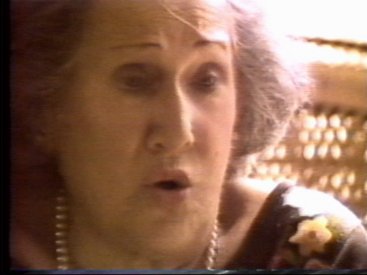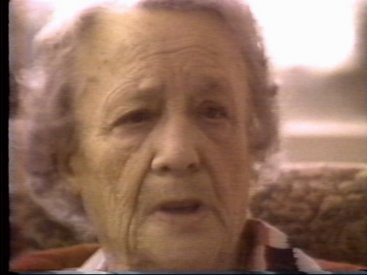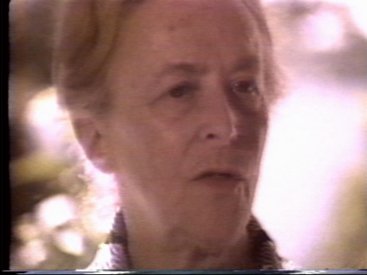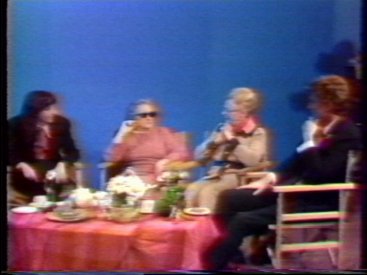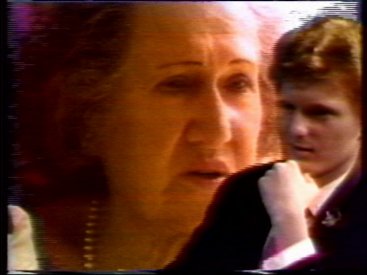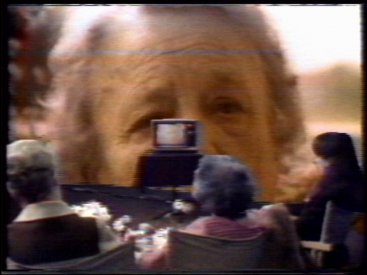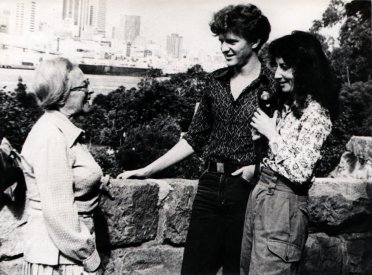Grandma Rose, Elsie Mae and Lottie
3/4” U-matic colour video, sound, 38mins.
Produced by Kimble Rendall and Carole Sklan.
Studio sequences produced at Paddington Video Access, Paddington Town Hall,
The video was shown at Videozone, July 9, 1978, Video Mayfair, May 1979 and included in the travelling collection Videotapes From Australia, 1979-80
Short biogs of the producers from the Videotapes From Australia catalogue.
Kimble Rendall: Arts degree in Education and mass media. Worked as a film editor with the Australian Broadcasting Commission and a variety of production houses. Completed a number of short films. Travelled the world and worked with filmmakers in Chile and London. Interest in video began with community video group in London. Has temporarily abandoned such media and joined a rock'n'roll band, the XL CAPRIS.
Carole Sklan: English graduate of Sydney University. Worked as a tutor/lecturer in general studies department. After a variety of research/clerical jobs, attended various video courses and worked as a member of Women's Action Theatre performing in schools, colleges, theatres, conferences and streets. Currently studying film at Swinburne Tech. in Melbourne.
In a review of the showing of Grandma Rose, Elsie Mae and Lottie at the 1979 Video Mayfair, Tom Zubrycki comments: “Traditionally tapemakers' work has been personal and subjective. This can either manifest itself in a clearly stated ideological position, or it may take the form of trying to break down relationships between producer and subject, and producer and audience. The latter intention went into the making of Grandma Rose, Elsie Mae and Lottie. Kimble Rendall and Carole Sklan constructed the final script only after several months of taping and playback with the three women. One scene in the tape actually shows [two of] the women being brought back into the studio by the producers and records their reaction to seeing themselves on tape.”1
The following is an article by Kimble Rendall that appeared in the May 1979 issue of Filmnews as part of a section on the 1979 Video Mayfair.
“What Inspired the Tape? The women. Here are three immigrant women living in Sydney, who have sharply contrasting personalities, life styles, philosophies and experience, their lives spanning the history of the twentieth century.
Most of us know an elderly friend or relative with a lot to tell, it seemed simple enough to set up a video camera and record their stories. We wanted the women to talk for themselves about their lives attitudes and involvements.
Elsie Mae is my grandmother and Carole knew Rose and Lottie through her family, so we had little trouble in establishing rapport. In order to ease the women into talking to the cameras, we carried out preliminary interviews on 1/4" magnetic tape and 1/2" black and white video. By the time it came to do the interviews with the colour portapak, the women were telling us how to set up the equipment. They generally seemed at ease with the gear, particularly after we replayed the interviews through the system. They were delighted in seeing and hearing themselves.
The script was developed through our interactions with the women over the period that we've known them. That is, we knew certain areas of their lives that interested us and there were also areas about which the women enjoyed talking. Obviously, we couldn't cover the entire lives of three women in forty minutes. We also wanted an audience to remain awake through the tape, so we eventually chose areas of prime interest. For instance, their impressions of Australia on arrival, war experiences, romance, courtship, marriage, responses to the suffragette movement, the vote, women's liberation movement. These are three ordinary women who would never, in the normal course of things, become subjects for a film/tape. Yet, they are quite extraordinary characters. We wanted to show old age in a positive way, showing women who have been through suffering, some of the most frightful extremity, but who still find reason to live.
Elsie Mae is aged 86 and lives with her family at a pub in St. Mary's. Born in London, she worked as a fashion mannequin. She met her husband, Frank, during World War 1, and they married in London and moved to Australia. Elsie was regarded as rather unconventional at that time for her dress, speech and 'unfortunate' habits she had acquired in Europe. The natives became particularly restless when she dared to smoke a cigarette in public. During peacetime, Frank and Elsie managed hotels, and they travelled around NSW and Queensland. Whenever Frank went to war, it was Elsie who managed the hotels and raised a family of four. After Frank and their son Keith were both captured in Germany and interned in the same P.O.W. camp, Elsie started a Wives of Prisoners at War Society and provided mutual support for women in a similar situation. With great inner strength and calm, Elsie Mae is quietly perceptive of those around her.
Grandma Rose is an 80 year old American who lives in Vaucluse with her daughter and husband, a doctor. She started in New York as a dress designer and eventually moved to Florida where she ran a dress shop, 'Madam Rose'. Rose exudes Miami miasma - vulgarity, brashness and volume. She is outrageous, cranky, loudmouthed, bawdy, crude and hilarious; a flamboyant, wisecracking Mae West. Underneath the crusty toughness, she is extremely warm and generous. It is a softness totally without sentimentality.
Lottie is in her late sixties. She started as a teacher in Germany, and was part of the enormous cultural excitement generated between the World Wars (Part 1 & 2). She speaks with intense animation about the cabaret in Berlin, the jazz period and the investigators of the modern dance. Lottie's husband died after they moved to Australia and she now lives alone in the top half of a terrace in Balmain. She runs a small business and has started teaching English to migrants under the Government Scheme. Lottie has a well read ardent interest in the Arts and regularly attends opera ballet, theatre and concerts - generally by herself. Following such performances, she will give rapturous enthusiastic descriptions. She delights in company and conversation.
The simple idea quickly became complex. We wanted to experiment with video and move away from conventional forms of narrative documentary. As source material we gathered historical footage, music, super 8 footage of the women, 1/4" tapes for voice-overs, old photographs. We edited montages of various media images of women collected in magazines, advertising images, montages related to War and Romance, Marriage and Courtship. Thus, whilst the women remained at the core of the tape, we started to introduce our viewpoints through editing. Our supposed objectivity diminished. We encouraged anyone working on the tape (camera operators etc) to ask questions of the women in order to free the interviewers. For instance, we interviewed Rose with her next door neighbour during morning tea, a ceremony they have practised over twenty years. The individual interviews were carried out in the women's homes. We thought it would be worth recording, not only the women's reactions to their own interviews, but their reactions to each other. They had never met, so we arranged a meeting in a T.V. studio and recorded it. Unfortunately, Elsie Mae became very sick at that time (she's since recovered) and we could only interview Rose and Lottie in the studio.
So what about distribution? Grandma Rose makes the point in the tape that many independent productions end up collecting dust. We now have to put our energies into distribution. Copies will go to places like the Co-op, CarIton Media centre and Paddington. We want to show the tape to community groups, old age centres, women's organizations, schools. Of course, we'll have to do our own PR, pamphlets, posters etc. We want the tape to be seen, a primary objective is to encourage discussion.
Kimble Rendall2
1Tom Zubrycki, “& now, the 'Public Evidence' show.” Filmnews, May 1979, p.12.
2Kimble Rendall in the Program Notes to Video Mayfair 1979, in Filmnews, May 1979, p.9.
